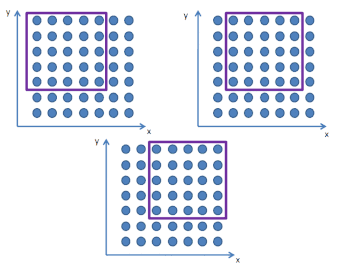Estimation of signal parameters via rotational invariance techniques
In estimation theory, estimation of signal parameters via rotational invariant techniques (ESPRIT) is a technique to determine parameters of a mixture of sinusoids in a background noise. This technique is first proposed for frequency estimation, however, with the introduction of phased-array systems in daily use technology, it is also used for Angle of arrival estimations as well.

General description
Let us define a signal vector as,
where represents the radial frequency of kth sinusoid. Let us construct a Vandermonde matrix for K number of sinusoids, such as
Let us divide the matrix A into two sets, such as
and
where is an identity matrix of size (m-1)-by-(m-1). It is clear that, contains the last (m-1) rows of A, while contains the first (m-1) rows of A.
Now, let us write the following relation,
Here, H is a diagonal matrix, where its diagonal elements can be written in a vector, such as,
In other words, the diagonal elements of H, are the complex exponentials with the radial frequencies of the set . Here, it is clear that H applies a rotation to the matrix . ESPRIT exploits similar rotations from the covariance matrix of the measured data.
To understand the algorithm itself, let us denote R as the covariance matrix of the measured data. By computing the eigenvalue decomposition of R (via algorithms like singular value decomposition), the following can be written,
where E is a diagonal matrix that contains the eigenvalues of R, in a decreasing order. Here, by finding the eigenvalues that are higher than the variance of the noise, we can separate the orthonormal eigenvectors from U, that correspond to these eigenvalues. This can be noted as where we kept only the first K columns.
As similar before, we can make the following separation on S,
and .
Moreover, there exists a relation between S and A such as , where the content of the matrix F is known, but irrelevant for the current subject. We can derive the following relations,
(where we made use of and ).
It is clear that the matrix P contains rotational information with respect to the frequency contents, such that the rotation on the first set of orthonormal eigenvectors yield to the second set. Moreover, the eigenvalues of P are equal to the diagonal elements of H. Therefore, by solving the following equation for P,
we can estimate the frequency content. To achieve this, the above equation can be solved with pseudo inverse (via Least squares) method.
To do so, can be written.
Finally, by finding the angles of the eigenvalues of P, one can estimate the set .
Algorithm example
A pseudo code is given below for the implementation of ESPRIT algorithm.
function esprit(y, model_order, number_of_sources):
m = model_order
n = number_of_sources
create covariance matrix R, from the noisy measurements y. Size of R will be (m-by-m).
compute the svd of R
[U, E, V] = svd(R)
obtain the orthonormal eigenvectors corresponding to the sources
S = U(:, 1:n)
split the orthonormal eigenvectors in two
S1 = S(1:m-1, :) and S2 = S(2:m, :)
compute P via LS (MATLAB's backslash operator)
P = S1\S2
find the angles of the eigenvalues of P
w = angle(eig(P))
return w
See also
References
- Paulraj, A.; Roy, R.; Kailath, T. (1985), "Estimation Of Signal Parameters Via Rotational Invariance Techniques - Esprit", Nineteenth Asilomar Conference on Circuits, Systems and Computers, pp. 83–89, doi:10.1109/ACSSC.1985.671426, ISBN 978-0-8186-0729-5.
- Roy, R.; Kailath, T. (1989). "Esprit - Estimation Of Signal Parameters Via Rotational Invariance Techniques" (PDF). IEEE Transactions on Acoustics, Speech, and Signal Processing. 37 (7): 984–995. doi:10.1109/29.32276..
- Ibrahim, A. M.; Marei, M. I.; Mekhamer, S. F.; Mansour, M. M. (2011). "An Artificial Neural Network Based Protection Approach Using Total Least Square Estimation of Signal Parameters via the Rotational Invariance Technique for Flexible AC Transmission System Compensated Transmission Lines". Electric Power Components and Systems. 39 (1): 64–79. doi:10.1080/15325008.2010.513363.
- Haardt, M., Zoltowski, M. D., Mathews, C. P., & Nossek, J. (1995, May). 2D unitary ESPRIT for efficient 2D parameter estimation. In icassp (pp. 2096-2099). IEEE.